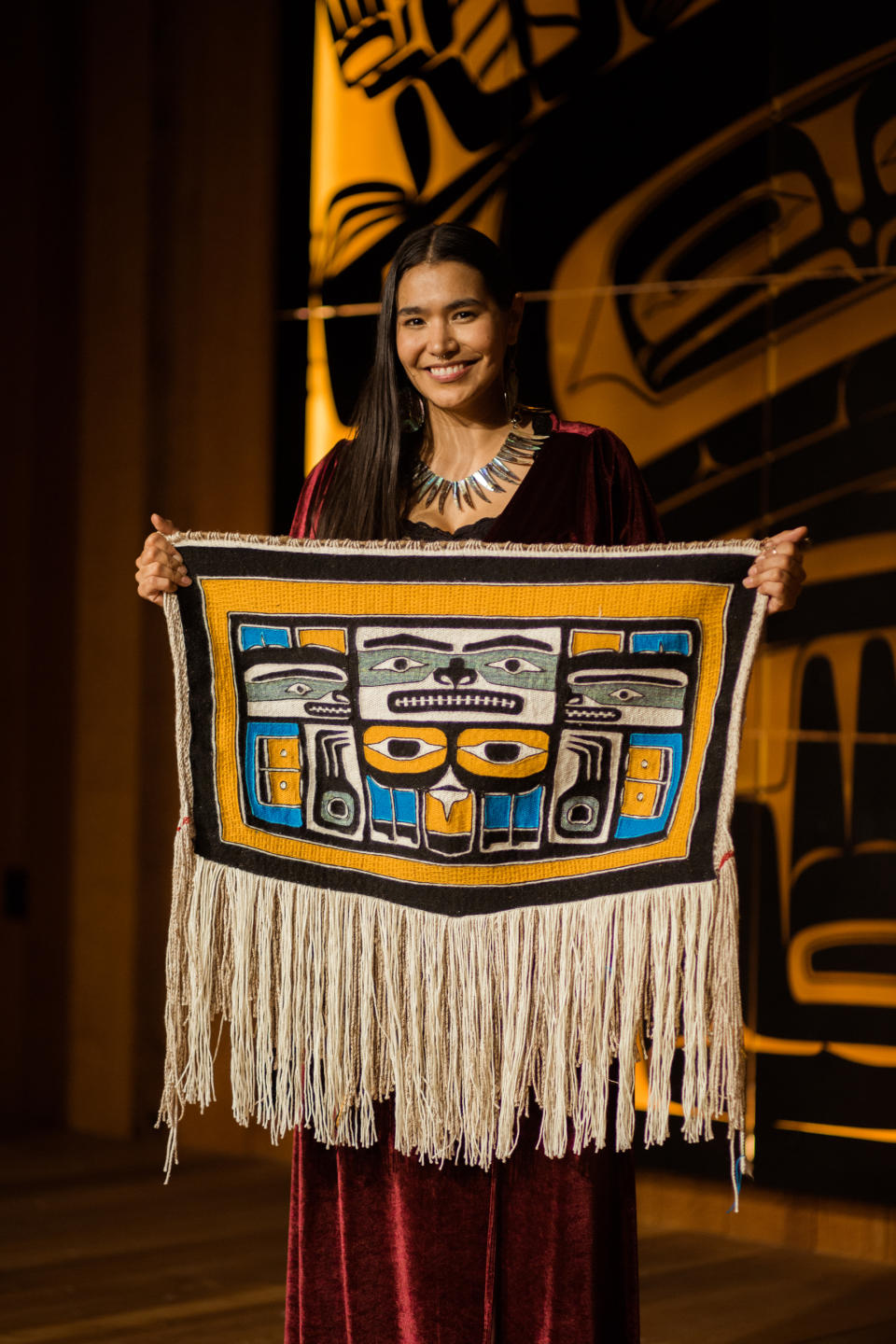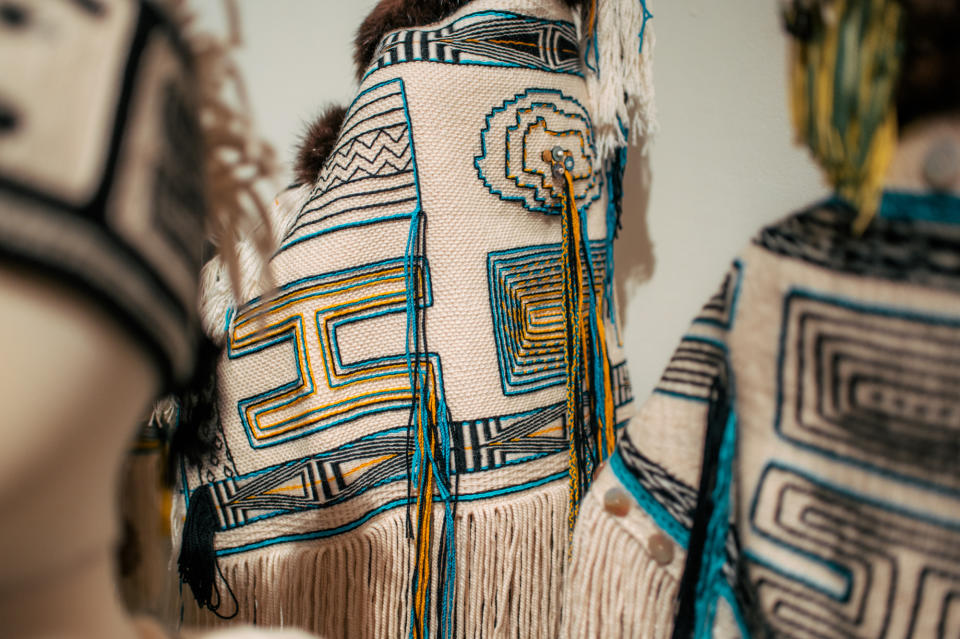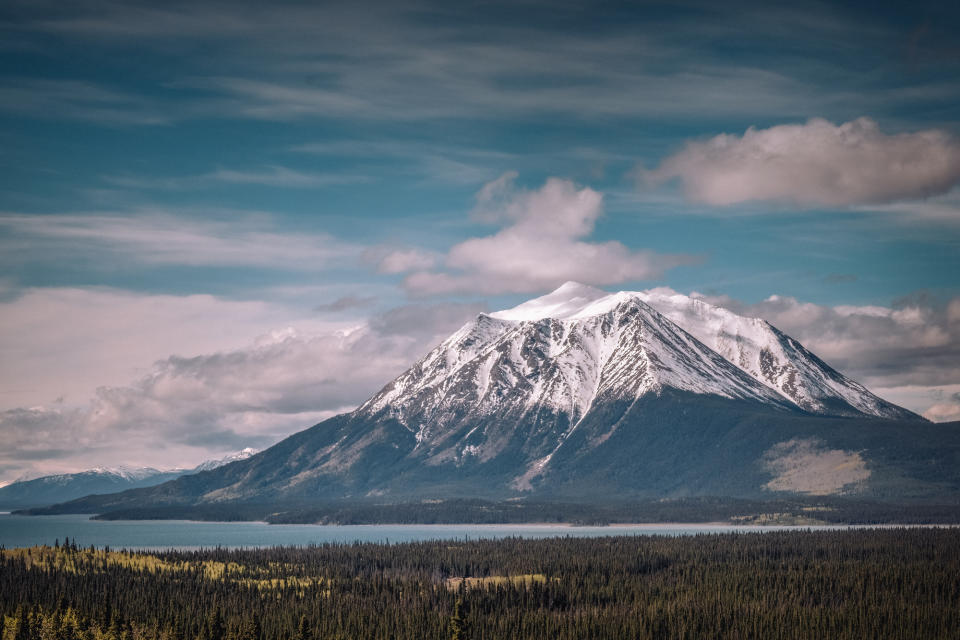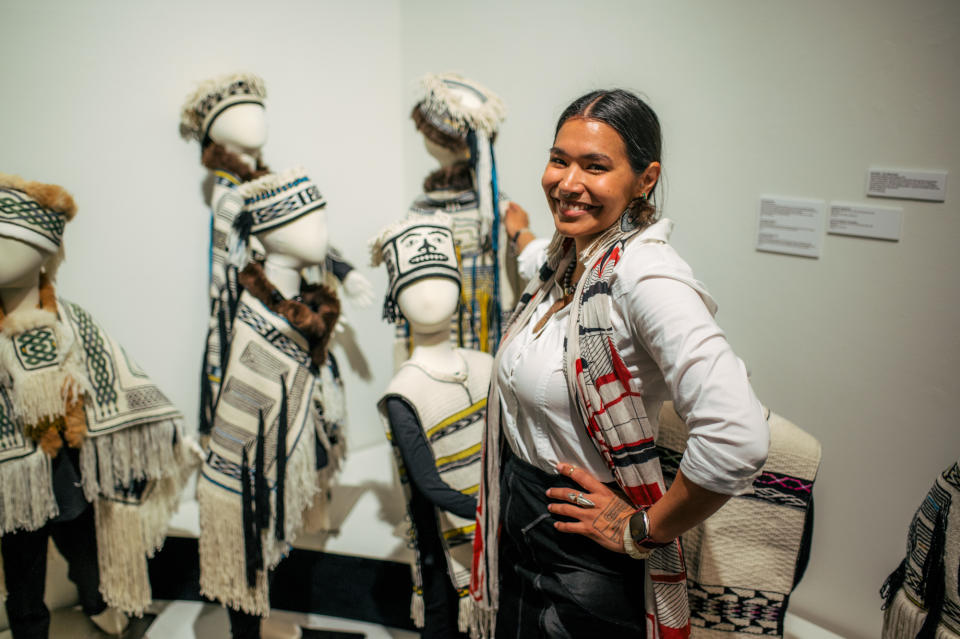Tlingit artist Donedin Jackson weaves robes that transcend generations and realms
Tlingit weaver Donedin Jackson talks excitedly as she walks the steep path towards the Juneau-Douglas City Museum in “Alaska,” where one of her weavings is on display.
The child-sized Yéil Koowú Ravenstail robe created by Jackson — with bright shades of yellow and blue contrasting with black and white — is being shown alongside more than 20 other weavings as part of the “Yéil Koowú Átx’i Khaa Sháade Nákhx’i Yán Sákw Jeeyís: Ravenstail Regalia for Future Leaders” collection.
The robes were danced ceremonially in “Juneau” in April, marking the largest collection of Ravenstail robes to be danced together since colonization of Tlingit territories.
“Weaving is therapeutic, centring,” says Jackson, an apprentice under master weaver Lily Wooshkindein Da.áat Hope.
“Even when I’m not weaving, I’m thinking about weaving — the patterns, the projects, the science behind the dyes, how we can harvest and how we can connect it to the land. All of the different interconnected aspects of it are just speaking to me at all times.”
Jackson is a fourth generation Shaxʼsaani Kéekʼ Jennie Thlunaut weaver of Ravenstail and its close relative Naax̲éin Chilkat.
Both styles of weaving are practiced by Tlingit, Haida, and Tsimishian peoples of the Northwest Coast, and Chilkat weaving in particular is thought to be one of the most complex weaving techniques in the world. A full-size robe can take between one to five years to complete.
After growing up deprived of her Tlingit culture, Jackson found herself working as a government executive in Treaty 7 territories in “Lethbridge, AB” but she knew something was missing.
When the COVID-19 pandemic hit, she started on a journey to reconnect with her culture and homelands, which span from Deisleen (Teslin) region in the “Yukon” down into the Áa Tlein (Atlin) region in “B.C.” and hugging the southeast coast of “Alaska.”
In 2021, Jackson joined a cohort of weavers and started a year of material preparation to create her first Chilkat child-sized robe. In March 2022, with all the materials ready, she began to weave. Three months into the weaving, Jackson was in a serious car accident. Her van went up in flames, along with her weaving. But she overcame the setback, restarting from scratch, and six months later the weaving, titled “For The Stolen: A Journey Into Healing,” was featured in the collective exhibition at the Juneau-Douglas City Museum.
Jackson kept creating and, in 2023, she started work on the Ravenstail robe now being shown in Juneau.
Despite colonial policies aimed at extinguishing Chilkat and Ravenstail weaving practices, Jackson is part of a new generation of more than 30 artists who have developed the technical and spiritual knowledge and skill to weave full sized ceremonial robes.
IndigiNews spoke to Jackson about how the practice has become a way for her to heal from colonial trauma and revitalize aspects of Tlingit culture that colonialism attempted to eradicate. This Q&A has been edited for length and clarity.

Mike Graeme: How did you come to be part of the revitalization of Chilkat and Ravenstail weavings, and how has the process been for you to reconnect with your Tlingit culture?
Donedin Jackson: It’s a little surreal to be carrying this tradition because I didn’t grow up in it. I wasn’t raised at the feet of our masters, being exposed to our traditions and our practices in my everyday life. I was raised in southern Alberta, removed from my culture and my people, and my place, and my history. The town I grew up in was a white place full of white people, and beyond my brother and I, there were maybe two other kids of colour in the entire community where we grew up.
So, coming to my homelands and learning to weave is very much a returning for me, a way to reconnect culturally on many levels. Weaving goes hand in hand with the language, the culture, and the heritage. Everything is tied up together, and I recognize it is a huge honor and a privilege for me to be in these spaces.
MG: Has learning to weave and reconnect with your Tlingit culture been a healing process for you?
DJ: A healing process is a really great way of describing it. When I was growing up, I had no concept of my Indigeneity, as colonialism intended for us. We were taught about Indigenous peoples as if we no longer existed. It took me a long time to be educated on what had happened to us collectively as a people, and I learned that my grandmother went to residential school. I learned the reason my grandmother wasn’t able to show me the kindness I wanted was because of the trauma that she carries because of what happened to her.
She fought tooth and nail to make sure my dad didn’t go because her own brother died at residential schools, and her mom didn’t learn that he had passed for over a year. It took over 20 years for them to find where he was buried. Residential schools were intended genocide, and that ripple effect carried through our family. My father wasn’t around to parent me because he didn’t know how to be a parent, because his own mother was traumatized.
I went out of my way in my early 20s to find my Tlingit family and track them down, which has led to me reconnecting with our cultural practices. Now I tell people that I am the success story of the Canadian government’s attempt to eradicate my people because I had no land, I had no history, I had no ties to the language or to our traditional practices. But jokes on them, they just made me really angry and it pushed me to do things to resolve the issues more than anything else.
MG: What happened to Tlingit weavings during colonization?
DJ: When the first colonizers arrived, they labeled us as savages who didn’t even have a written language, when in reality, our formline is our written language. It was found on everything, from our weavings to house fronts, to screens, to wall-hangings, to spoons, to bowls, to literally any functional piece we made.
Children were forced into residential schools in an attempt to assimilate us. Our weavings, along with other cultural practices, were outlawed by both the Canadian and United States governments. Colonial governments made it prosecutable by law to host potlatches and participate in relevant activities. So, many of these practices went underground, and some were lost completely. Our Ravenstail weaving practice was forced asleep, and so we’ve actually had to revitalize the Ravenstail practice by examining historic weavings and remnants found in institutions or those kept by our families.
Our Chilkat weavings, on the other hand, did not entirely go to sleep. At any given time in the last 300 years, there were at least 12 weavers who carried the ceremonial, traditional, and practical knowledge of how to create our regalia in the right way. But, unfortunately, we’ve lost a lot of the original meanings of the formline, and now it is widely considered an esthetic, an art style, as opposed to a written language. I take qualms with hearing that we’ve never had a written language because we have used our ceremonial regalia to record stories, settle land claims, prove providence, and to show our history. It was how we recorded our significant events; it was all in our weaving. Our regalia is our written record, our official documentation.
MG: Speaking of settling land claims, I learned at the Klukwan cultural centre that Lukaax.ádi Elder Austin Hammond once used a Chilkat robe in the U.S. courts in lieu of a ‘written deed’ to show his clan’s ownership of Chilkoot homelands. Were land claims on your mind when you were weaving your most recent Ravenstail robe that is on display in the Juneau-Douglas City Museum?
DJ: Yes, our robes are how we used to keep our chronologies. They are our oratory history and our historical documentation, so they have been used to prove that we are of the land, and this robe is going to carry that tradition forward. I wove a topographical depiction of Mt. K’iyán into my most recent Ravenstail robe to give material representation to our oral history of the mountain.


On the woven image of Mt. K’iyán, you’ll see three brass buttons and three abalone buttons, near to the yellow, black, and blue threads coming out of the mountaintop. The brass buttons represent three cannons that the Tlingit people traded with the Russians during the 1800s. The Spanish were invading from the south, and so we traded three wives — which are represented by the three abalone buttons — for three cannons, and in doing so we were able to defend our traditional territory and retain the hereditary rights to the land. These cannons are still buried somewhere out on the land and are going to possibly be exhumed and used in our defense for our land title during treaty negotiations.
You can also see that the robe is divided up into different sections. The reason the very last block on the design of the robe was left blank is because our treaty is incomplete. We are still negotiating our land treaty in northern B.C. Ninety-six per cent of B.C. is unceded territory, and so Taku River Tlingit First Nation is still negotiating our treaty. Therefore the robe is incomplete, because our treaty has not been finished, directly reflecting where we are currently in history. With the return of the traditional names to the mountain and acknowledgement of the traditional peoples and our hereditary ties to the land, I will then complete the robe.
MG: Is there a reason for using these colours?
DJ: The process of weaving represents a sacred connection to the spirit world. We believe the warp hanging down from the loom is the veil between worlds. And so when we’re weaving, we’re literally pulling something from one side of the veil into being in this reality.
I actually had a dream where I was weaving this robe. And you can see I’ve woven the centers of the diamonds along the perimeter in the colour white, except for the top middle ones. I was going to have them all black, but in the dream, I was talking to someone, and they said, ‘No, no, it needs to be white for all of the ancestors surrounding us, all of the ones on the other side of the veil, and the center ones can be done in black to represent us here on this side of the veil.’ And I woke up and thought, okay, message received. I try to be able to hear our ancestors when they speak to us. I don’t know who it was who came to me in my dream, or what intention or meaning they had, but I had received the instruction. I don’t like to offend our ancestors. They’ve gotten me this far, so when they give advice, I’m gonna take it.
As for the yellow, it represents the spirit of our ancestors of our past, while the blue represents the spirit of our people and our connection as people of water, which we are known as, to the land here. The blue on Mt. K’iyán represents the water falling from the top of the mountain. And the top of the mountain is woven with yellow since the top of mountains is where we are closest to our ancestors.
MG: As robes are so important to history, land claims, and holding other knowledge, where have the majority of ancestral Chilkat and Ravenstail robes ended up?
DJ: A significant number of our regalia have been sold in private sale and bought by private collectors. Another significant portion of robes are being held by institutions that refuse to return them to their traditional peoples, citing either lack of proof that we are the original caretakers of them, or the lack of facilities to care for them — as if we don’t know how to take care of our own regalia. Many of these institutions demand we prove our connection to the regalia by providing photographs of their use in ceremony, and one of the things that we never used to do is to allow photography during ceremony. So they’re adding additional barriers to prevent traditional peoples from reclaiming their regalia.
The largest collection of robes that we know of, at least in public-facing institutions, can be found in Russia, because the Russians have quite a fondness for Tlingits, and would come over to our land and collect many of our traditional pieces.
MG: Last June, the Taku River Tlingit were forced to pay almost $40,000 to bring home a 140-year old robe that was taken from the community. How do you feel about having to buy back cultural items that were stolen?
DJ: It’s an insult on top of injury because instead of repatriating, they’re forcing us to participate in the colonizer practice of purchasing our ceremonial goods that were probably never meant to be sold in the first place. Since there is no legislation in Canada for repatriation like there is in the United States, it is a lot harder for the First Nations to be recognized as the original creators and caretakers of these pieces. We’re working on remedying this and having some of our own Archaeological Resources Protection Act (ARPA) laws put in place. But as it is, there’s no strong legal precedent for repatriation.
MG: On the subject of ‘taking care’ of regalia, many of these weavings that were stolen were desecrated in the process. Do you want to say anything about that, as well as how current weavers are helping these weavings live on through the creation of replicas?
DJ: When institutions would collect weavings from the ‘savage people,’ they would make sure to use pesticides like arsenic, lead-based solvents, formaldehyde, and other poisons to kill any bugs they believed the robes would have on them, and so now these treated robes are no longer considered medicine to us. You can’t put something completely coated in arsenic on your body, and tell me that’s good for you.
Beyond this, we consider our weavings to be living beings. Anybody who has ever witnessed our traditional regalia will tell you that they have a spirit — they are alive, they are beings within themselves. So, the disrespect shown to our robes extends to the spirits within them. We have whole family lines that are charged with the caretaking of our weavings because these beings outlive us by generations.
Since many of our robes have been made toxic, one of the things that my mentor Lily Hope specializes in is replicas — museum quality replicas — so that the original weavings can be retired because they cannot be used in ceremony. This presents an opportunity for an apprenticing weaver to learn to weave by replicating our old weavings.
But once a replica is woven, the institution that had the original might keep the replica. At best, some of these institutions do allow members of the First Nation to check out their pieces for ceremony, so you can actually go in and request that they be made available for specific events, but there should be full Indigenous stewardship over the robes to begin with, so we no longer have to go through the colonizers’ institutions to get access to our ceremonial regalia.
MG: What gives you hope for your future and the future of weaving?
DJ: I am still just pinching myself, realizing what I am doing and this calling that has been placed upon me. I’m just trying to carry that knowledge in a good, ethical way, following the leadership of my masters and my mentors, and to be able to respect and honor the traditions that have been passed down and are reawakening.
As of today, due to the efforts of many weavers, including my master Lily Hope, there are now over 30 of us who carry this ceremonial and traditional knowledge to create these beings. And so I like to joke that Lily has created her own little army of weavers, and we’re going forward, we’re carrying the practice in a good way, and we’re creating new apprentices with every commission and request for the creation of regalia.
One thing I’ve noticed is that on the U.S.-side of our homelands, there is a lot more recognition of the weaving practice, whereas in Canada, it’s still becoming acknowledged, and so my hope is that it will continue to become more prolific. And it’s already snowballing. All of the weavers who’ve been trained under Lily have been tasked with training new apprentices, with touring around and traveling and teaching, as well as returning this knowledge back into the traditional communities that it belongs to. It is an honour and a privilege to be able to carry this knowledge and offer it back to its people and see it thrive, not just survive.

Reporting for this story was made possible in part through funding from the Real Estate Foundation of BC, a philanthropic organization working to advance sustainable, equitable, and socially just land use across the province.
Mike Graeme, Local Journalism Initiative Reporter, IndigiNews


